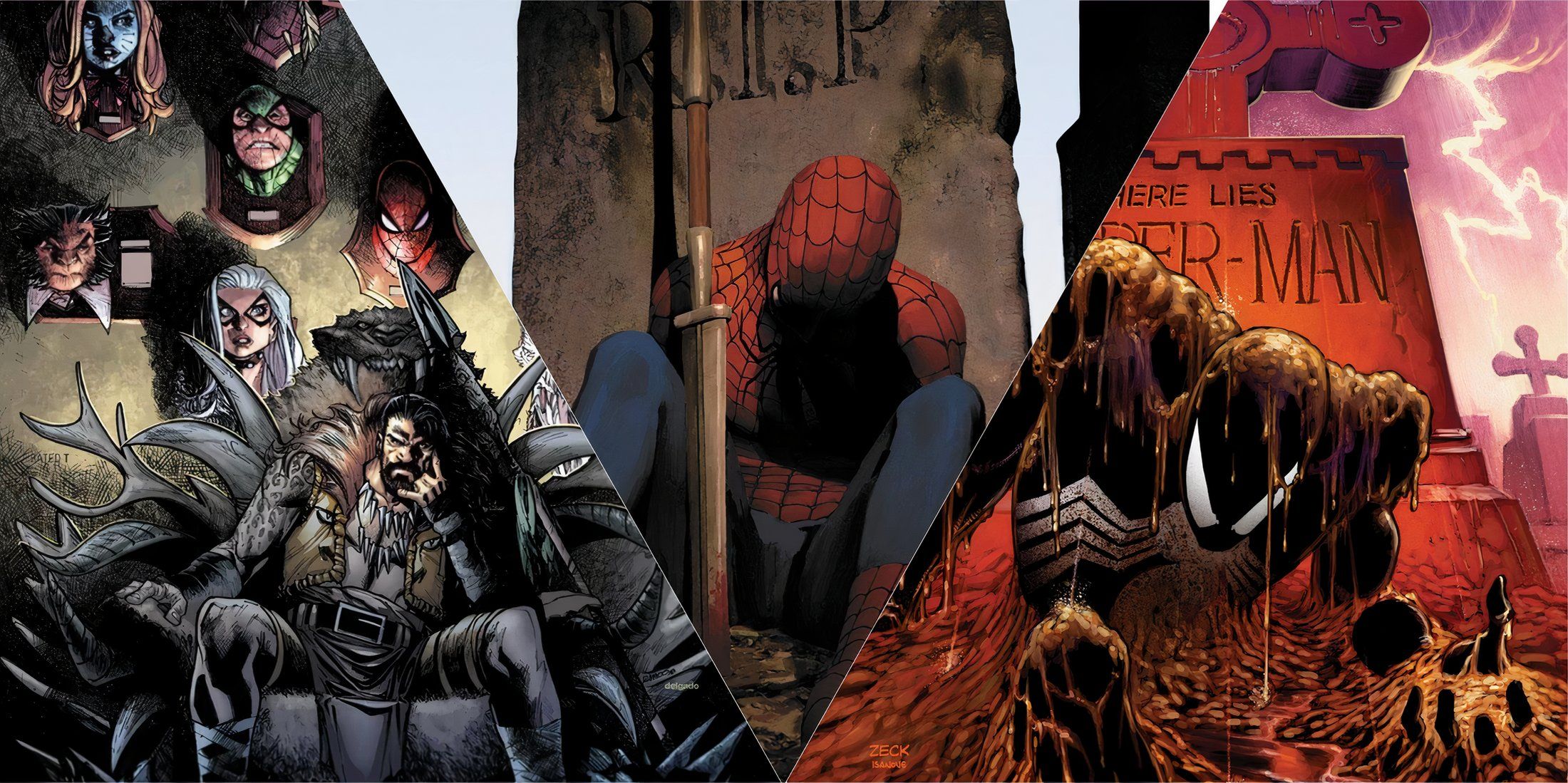0 Comments
0 Shares
111 Views

Directory
Directory
-
Please log in to like, share and comment!
-
 GAMERANT.COMTimes Kraven The Hunter Defeated Spider-ManSergei Kravinoff, better known as Kraven The Hunter, is the best hunter in the Marvel universe and often comes toe-to-toe with Spider-Man in an attempt to prove himself as the ultimate hunter and warrior. Kraven is one of the most cunning Spider-Man villains, taking a more tactical and strategic approach when fighting the wall-crawling hero.0 Comments 0 Shares 113 Views
GAMERANT.COMTimes Kraven The Hunter Defeated Spider-ManSergei Kravinoff, better known as Kraven The Hunter, is the best hunter in the Marvel universe and often comes toe-to-toe with Spider-Man in an attempt to prove himself as the ultimate hunter and warrior. Kraven is one of the most cunning Spider-Man villains, taking a more tactical and strategic approach when fighting the wall-crawling hero.0 Comments 0 Shares 113 Views -
 GAMERANT.COMThe Best Military Horror GamesHorror has long proved to be one of the most popular genres for exploring important topics, including PTSD, guilt, grief, and abuse, to name a few. Horror games urge players to confront their fears, and in a world of conflict and nuclear threat, military scenarios are becoming increasingly popular backdrops.0 Comments 0 Shares 97 Views
GAMERANT.COMThe Best Military Horror GamesHorror has long proved to be one of the most popular genres for exploring important topics, including PTSD, guilt, grief, and abuse, to name a few. Horror games urge players to confront their fears, and in a world of conflict and nuclear threat, military scenarios are becoming increasingly popular backdrops.0 Comments 0 Shares 97 Views -
 WWW.DEZEEN.COMThe top 10 chairs of 2024For the latest instalment of our 2024 review, we've compiled the most popular chairs published on Dezeen Showroom over the course of the year, including a chair referencing the design of houses in Thailand.Clam chair by Arnold Madsen and DagmarA bulbous seat wrapped in sheepskin and rounded wooden legs combine to form Danish upholstererArnold Madsen's Clam chair, which was originally designed in 1944.Recently brought back into production by British brandDagmar, the chair has a soft, timeless appearance and can be upholstered in a range of materials.Find out more about Clam Able chair by Bl StationA canvas or leather seat and backrest are stretched across a rectilinear steel frame in the Able chair by Swedish furniture brandBl Station.The chair can be specified with casters in place of feet, and the frame and fabric elements come in a range of colourways for increased personalisation.Find out more about Able Sala chair by Natthorn Uliss for lii Design StudioThe design of houses in Thailand was the main touchpoint for designer Natthorn Uliss when creating this wooden chair for furniture brandlii Design Studio.Rounded timber rods were used alongside a pair of wooden planes in the Sala chair, which can be made from mahogany, beech or oak wood.Find out more about Sala Moon chair by Mark Litvyakov for WigiwamaThree separate components come together to form this chair released by children's furniture brandWigiwama.The modular Moon chair is upholstered in tactile corduroy or teddy fabric and can be disassembled to be used as equipment for other forms of play, such as fort building.Find out more about Moon Goodwood chair by MorganThe shapes of hand-carved sculptures and mobiles informed the appearance of this lounge chair by British furniture brand Morgan.The Goodwood chair comes in two iterations one with cut-out armrests and one where they are filled in and appear to be uniform with the seat and backrest.Find out more about Goodwood Bud chair by Fora FormA C-shaped, tubular backrest envelopes anyone sitting in the Bud chair by Scandinavian brandFora Form.The aim of the design was to provide a more cheerful alternative to conventional task chairs, which Fora Form tackled by using rounded forms and playful colourways.Find out more about Bud Mosso chair by PommierFurniture design company Pommier created this solid wooden chair to have a light, free-flowing appearance.The Mosso chair is made from FSC-certified timber that was carved to create arching shapes and rounded corners.Find out more about Mosso Specere chair by Andreas Krob for OkamuraDesign motifs found in mid-century drafting chairs were paired with modern ergonomic technology to create this monochromatic task chair.Created by designer Andreas Krob for Japanese office furniture brand Okamura, the Specere chair was designed to offer users both support and physical flexibility, as well as timeless seating solutions for offices and workspaces.Find out more about Specere Samba dining chair by David Aguirre for AguirreFibreglass was the main material used for American furniture brand Aguirre's Samba dining chair, and the chair's unusual materiality is matched by its distinctive design.Samba is made up of a branching backrest, chunky legs and a plush upholstered seat and comes in black, beige and green. The seats can be combined with a choice of upholstery materials.Find out more about Samba Faneeri folding chair by Jonas Forsman for NikariDesigned to appear elegant both when folded away and in use, this chair released by Finnish brand Nikari was created by designer Jonas Forsman.The Faneeri folding chair is made of lacquered oak and features an ultra-thin backrest and seat, allowing it to take up little space when not being used.Find out more about Faneeri The post The top 10 chairs of 2024 appeared first on Dezeen.0 Comments 0 Shares 127 Views
WWW.DEZEEN.COMThe top 10 chairs of 2024For the latest instalment of our 2024 review, we've compiled the most popular chairs published on Dezeen Showroom over the course of the year, including a chair referencing the design of houses in Thailand.Clam chair by Arnold Madsen and DagmarA bulbous seat wrapped in sheepskin and rounded wooden legs combine to form Danish upholstererArnold Madsen's Clam chair, which was originally designed in 1944.Recently brought back into production by British brandDagmar, the chair has a soft, timeless appearance and can be upholstered in a range of materials.Find out more about Clam Able chair by Bl StationA canvas or leather seat and backrest are stretched across a rectilinear steel frame in the Able chair by Swedish furniture brandBl Station.The chair can be specified with casters in place of feet, and the frame and fabric elements come in a range of colourways for increased personalisation.Find out more about Able Sala chair by Natthorn Uliss for lii Design StudioThe design of houses in Thailand was the main touchpoint for designer Natthorn Uliss when creating this wooden chair for furniture brandlii Design Studio.Rounded timber rods were used alongside a pair of wooden planes in the Sala chair, which can be made from mahogany, beech or oak wood.Find out more about Sala Moon chair by Mark Litvyakov for WigiwamaThree separate components come together to form this chair released by children's furniture brandWigiwama.The modular Moon chair is upholstered in tactile corduroy or teddy fabric and can be disassembled to be used as equipment for other forms of play, such as fort building.Find out more about Moon Goodwood chair by MorganThe shapes of hand-carved sculptures and mobiles informed the appearance of this lounge chair by British furniture brand Morgan.The Goodwood chair comes in two iterations one with cut-out armrests and one where they are filled in and appear to be uniform with the seat and backrest.Find out more about Goodwood Bud chair by Fora FormA C-shaped, tubular backrest envelopes anyone sitting in the Bud chair by Scandinavian brandFora Form.The aim of the design was to provide a more cheerful alternative to conventional task chairs, which Fora Form tackled by using rounded forms and playful colourways.Find out more about Bud Mosso chair by PommierFurniture design company Pommier created this solid wooden chair to have a light, free-flowing appearance.The Mosso chair is made from FSC-certified timber that was carved to create arching shapes and rounded corners.Find out more about Mosso Specere chair by Andreas Krob for OkamuraDesign motifs found in mid-century drafting chairs were paired with modern ergonomic technology to create this monochromatic task chair.Created by designer Andreas Krob for Japanese office furniture brand Okamura, the Specere chair was designed to offer users both support and physical flexibility, as well as timeless seating solutions for offices and workspaces.Find out more about Specere Samba dining chair by David Aguirre for AguirreFibreglass was the main material used for American furniture brand Aguirre's Samba dining chair, and the chair's unusual materiality is matched by its distinctive design.Samba is made up of a branching backrest, chunky legs and a plush upholstered seat and comes in black, beige and green. The seats can be combined with a choice of upholstery materials.Find out more about Samba Faneeri folding chair by Jonas Forsman for NikariDesigned to appear elegant both when folded away and in use, this chair released by Finnish brand Nikari was created by designer Jonas Forsman.The Faneeri folding chair is made of lacquered oak and features an ultra-thin backrest and seat, allowing it to take up little space when not being used.Find out more about Faneeri The post The top 10 chairs of 2024 appeared first on Dezeen.0 Comments 0 Shares 127 Views -
 WWW.CREATIVEBLOQ.COMInspired by the movie Elysium, this villainous 3D art delivers realism while staying out of the Uncanny ValleyInspired by the movie Elysium, this villainous render delivers realism while staying out of the Uncanny Valley0 Comments 0 Shares 116 Views
WWW.CREATIVEBLOQ.COMInspired by the movie Elysium, this villainous 3D art delivers realism while staying out of the Uncanny ValleyInspired by the movie Elysium, this villainous render delivers realism while staying out of the Uncanny Valley0 Comments 0 Shares 116 Views -
 WWW.CREATIVEBLOQ.COMThe illustration trends set to take shape in 2025Immersive, character-led, handcrafted and unique, these are the illustration trends for the year ahead.0 Comments 0 Shares 118 Views
WWW.CREATIVEBLOQ.COMThe illustration trends set to take shape in 2025Immersive, character-led, handcrafted and unique, these are the illustration trends for the year ahead.0 Comments 0 Shares 118 Views -
 WWW.WIRED.COMAs Birth Rates Plummet, Women's Autonomy Will Be Even More at RiskNations are more focused than ever on declining populations. Women, along with gender and sexual minorities, will see their rights come under fire.0 Comments 0 Shares 109 Views
WWW.WIRED.COMAs Birth Rates Plummet, Women's Autonomy Will Be Even More at RiskNations are more focused than ever on declining populations. Women, along with gender and sexual minorities, will see their rights come under fire.0 Comments 0 Shares 109 Views -
-
/https://tf-cmsv2-smithsonianmag-media.s3.amazonaws.com/filer_public/17/78/17780dd5-6289-4979-b87a-fe133667409b/gettyimages-3430968.jpg) WWW.SMITHSONIANMAG.COMOn This Day in 1890, the U.S. Army Killed Nearly 300 Lakota People in the Wounded Knee MassacreDating from 1940, this photograph depicts a sign at the site of the Wounded Knee Massacre, South Dakota, where 250 American Indians were killed in 1890. Photo by John Vachon / Library Of Congress / Getty ImagesAs initial reports of a mass murder of Lakota Native Americans on December 29, 1890, trickled across the nation, newspapers were quick to place the blame on the Lakota. Indian treachery once more made manifest, the headline in the Lincoln, Nebraska, State Journal read. Federal troops had killed between 150 and 300 people in southwestern South Dakota in an incident now known as the Massacre at Wounded Knee.It made sensational newswhat one paper called exciting scenes.But these breathless accounts only told the story of the immediate events that led to the massacre. Deeper forces were at play, and a larger context of wars between Plains Indians and the encroaching U.S. government charged the events of December 29.Created in the aftermath of the Civil War, the Seventh Cavalry regularly engaged in violent clashes with Native Americans. The frontier regiment was known for its infamous defeat at the Battle of Little Bighorn under George Custer 14 years prior. Now, Sitting Bull, the Hunkpapa Lakota warrior who had roused his people at Little Bighorn, had been murdered by federal Indian police.The regiment was tasked with intercepting, disarming and escorting the Miniconjou, a subdivision of the Lakota, along Wounded Knee Creek on December 28. The Miniconjou had long resisted the compromises of reservation life. But after Sitting Bulls murder a fortnight prior, their chief, Sitanka, or Big Foot, decided to lead about 350 of his people to Pine Ridge to seek protection from Red Cloud, whom historian Dee Brown called the last of the great chiefs in Bury My Heart at Wounded Knee: An Indian History of the American West.Commanded by James W. Forsyth, the troops waited until bright and early the next morning to avoid provoking the tribe, the St. Louis Globe-Democrat wrote. With four Hotchkiss machine guns mounted on a bluff overlooking the camp, the troops demanded the tribe forfeit its weapons. The Miniconjou complied. But the troops were unconvinced that the Miniconjou had really given up all their weapons. They searched the camp, shaking out blankets and rifling through tepees.The troops only found two rifles. One belonged to Black Coyote, a deaf member of the tribe who either didnt understand the orders or didnt want to comply. By some accounts, he fired first. By others, a soldier tried to grab his gun and it went off. Either way, a shot rang out and the massacre began.In the first seconds of violence, Brown wrote, the firing of carbines was deafening, filling the air with powder smoke. Sitanka died early on. Then, soldiers fired the Hotchkiss guns.We tried to run, a Miniconjou named Louise Weasel Bear reportedly said afterward. But they shot us like we were a buffalo.Sensationalist white accounts agreed. The soldiers shot the Indians down wherever found, no quarter being given by anyone, the Globe-Democrat reported.To say that it was a most daring feat, 120 Indians attacking 500 cavalry, expresses the situation but faintly, the Globe-Democrat continued. It could only have been insanity which prompted such a deed.In an impassioned speech following the massacre, Red Cloud, the leader of the Oglala Lakota whom the Miniconjou wished to ask for protection, offered a fuller explanation.I will tell you the reason for the trouble, he said. When we first made treaties with the Government, our old life and our old customs were about to end; the game on which we lived was disappearing; the whites were closing around us, and nothing remained for us but to adopt their ways.Red Cloud spoke of a saga of promises and hope that his people would one day attain prosperity. But ultimately, the Lakota were left voiceless and misrepresented. We begged for life and the white men thought we wanted theirs, Red Cloud said.As the sun set on December 29, there was little life left at Wounded Knee. The U.S. Army killed 300 Miniconjou, by some estimates, leaving them in the frozen plains and in mass graves, wounds dug into the American earth.Get the latest stories in your inbox every weekday.0 Comments 0 Shares 110 Views
WWW.SMITHSONIANMAG.COMOn This Day in 1890, the U.S. Army Killed Nearly 300 Lakota People in the Wounded Knee MassacreDating from 1940, this photograph depicts a sign at the site of the Wounded Knee Massacre, South Dakota, where 250 American Indians were killed in 1890. Photo by John Vachon / Library Of Congress / Getty ImagesAs initial reports of a mass murder of Lakota Native Americans on December 29, 1890, trickled across the nation, newspapers were quick to place the blame on the Lakota. Indian treachery once more made manifest, the headline in the Lincoln, Nebraska, State Journal read. Federal troops had killed between 150 and 300 people in southwestern South Dakota in an incident now known as the Massacre at Wounded Knee.It made sensational newswhat one paper called exciting scenes.But these breathless accounts only told the story of the immediate events that led to the massacre. Deeper forces were at play, and a larger context of wars between Plains Indians and the encroaching U.S. government charged the events of December 29.Created in the aftermath of the Civil War, the Seventh Cavalry regularly engaged in violent clashes with Native Americans. The frontier regiment was known for its infamous defeat at the Battle of Little Bighorn under George Custer 14 years prior. Now, Sitting Bull, the Hunkpapa Lakota warrior who had roused his people at Little Bighorn, had been murdered by federal Indian police.The regiment was tasked with intercepting, disarming and escorting the Miniconjou, a subdivision of the Lakota, along Wounded Knee Creek on December 28. The Miniconjou had long resisted the compromises of reservation life. But after Sitting Bulls murder a fortnight prior, their chief, Sitanka, or Big Foot, decided to lead about 350 of his people to Pine Ridge to seek protection from Red Cloud, whom historian Dee Brown called the last of the great chiefs in Bury My Heart at Wounded Knee: An Indian History of the American West.Commanded by James W. Forsyth, the troops waited until bright and early the next morning to avoid provoking the tribe, the St. Louis Globe-Democrat wrote. With four Hotchkiss machine guns mounted on a bluff overlooking the camp, the troops demanded the tribe forfeit its weapons. The Miniconjou complied. But the troops were unconvinced that the Miniconjou had really given up all their weapons. They searched the camp, shaking out blankets and rifling through tepees.The troops only found two rifles. One belonged to Black Coyote, a deaf member of the tribe who either didnt understand the orders or didnt want to comply. By some accounts, he fired first. By others, a soldier tried to grab his gun and it went off. Either way, a shot rang out and the massacre began.In the first seconds of violence, Brown wrote, the firing of carbines was deafening, filling the air with powder smoke. Sitanka died early on. Then, soldiers fired the Hotchkiss guns.We tried to run, a Miniconjou named Louise Weasel Bear reportedly said afterward. But they shot us like we were a buffalo.Sensationalist white accounts agreed. The soldiers shot the Indians down wherever found, no quarter being given by anyone, the Globe-Democrat reported.To say that it was a most daring feat, 120 Indians attacking 500 cavalry, expresses the situation but faintly, the Globe-Democrat continued. It could only have been insanity which prompted such a deed.In an impassioned speech following the massacre, Red Cloud, the leader of the Oglala Lakota whom the Miniconjou wished to ask for protection, offered a fuller explanation.I will tell you the reason for the trouble, he said. When we first made treaties with the Government, our old life and our old customs were about to end; the game on which we lived was disappearing; the whites were closing around us, and nothing remained for us but to adopt their ways.Red Cloud spoke of a saga of promises and hope that his people would one day attain prosperity. But ultimately, the Lakota were left voiceless and misrepresented. We begged for life and the white men thought we wanted theirs, Red Cloud said.As the sun set on December 29, there was little life left at Wounded Knee. The U.S. Army killed 300 Miniconjou, by some estimates, leaving them in the frozen plains and in mass graves, wounds dug into the American earth.Get the latest stories in your inbox every weekday.0 Comments 0 Shares 110 Views -
 WWW.MARKTECHPOST.COMThis AI Paper Proposes TALE: An AI Framework that Reduces Token Redundancy in Chain-of-Thought (CoT) Reasoning by Incorporating Token Budget AwarenessLarge Language Models (LLMs) have shown significant potential in reasoning tasks, using methods like Chain-of-Thought (CoT) to break down complex problems into manageable steps. However, this capability comes with challenges. CoT prompts often increase token usage, leading to higher computational costs and energy consumption. This inefficiency is a concern for applications that require both precision and resource efficiency. Current LLMs tend to generate unnecessarily lengthy outputs, which do not always translate into better accuracy but incur additional costs. The key challenge is finding a balance between reasoning performance and resource efficiency.Researchers from Nanjing University, Rutgers University, and UMass Amherst have introduced a Token-Budget-Aware LLM Reasoning Framework. This framework dynamically estimates token budgets based on the complexity of a reasoning task and uses these estimates to guide the process. Known as TALE (Token-Budget-Aware LLM rEasoning), the approach seeks to reduce token usage without compromising the accuracy of responses. By integrating a token budget into CoT prompts, TALE provides a practical solution for enhancing cost-efficiency in LLMs while maintaining their performance.Technical Details and BenefitsTALE operates in two main phases: budget estimation and token-budget-aware reasoning. Initially, it estimates an appropriate token budget for a problem using methods such as zero-shot prediction or regression-based estimators. This budget is then embedded in the prompt to encourage the LLM to generate concise yet accurate responses.A key innovation in TALE is the concept of Token Elasticity, which identifies an optimal range of token budgets that minimizes token usage while preserving accuracy. Using iterative search techniques like binary search, TALE determines the optimal budget for various tasks and LLM architectures. On average, the framework achieves a 68.64% reduction in token usage with less than a 5% decrease in accuracy, making it a practical and adaptable approach for token efficiency.Results and InsightsExperiments demonstrate TALEs effectiveness across benchmarks like GSM8K and MathBench. For instance, on the GSM8K dataset, TALE achieved 84.46% accuracy, surpassing the Vanilla CoT method while reducing token costs from 318.10 to 77.26 on average. On GSM8K-Zero, it reduced token costs by 91%, maintaining an accuracy of 98.72%.TALE also generalizes well across different LLMs, such as GPT-4o-mini and Yi-lightning. When applied to the MathBench-College dataset, TALE reduced token costs by up to 70% while maintaining competitive accuracy. Additionally, the framework significantly lowers operational expenses, cutting costs by 59% on average compared to Vanilla CoT. These results highlight TALEs ability to enhance efficiency without sacrificing performance, making it suitable for a variety of applications.ConclusionThe Token-Budget-Aware LLM Reasoning Framework addresses the inefficiency of token usage in reasoning tasks. By dynamically estimating and applying token budgets, TALE strikes a balance between accuracy and cost-effectiveness. This approach reduces computational expenses and broadens the accessibility of advanced LLM capabilities. As AI continues to evolve, frameworks like TALE offer a pathway to more efficient and sustainable use of LLMs in both academic and industrial contexts.Check out the Paper and GitHub Page. All credit for this research goes to the researchers of this project. Also,dont forget to follow us onTwitter and join ourTelegram Channel andLinkedIn Group. Dont Forget to join our60k+ ML SubReddit. Asif RazzaqAsif Razzaq is the CEO of Marktechpost Media Inc.. As a visionary entrepreneur and engineer, Asif is committed to harnessing the potential of Artificial Intelligence for social good. His most recent endeavor is the launch of an Artificial Intelligence Media Platform, Marktechpost, which stands out for its in-depth coverage of machine learning and deep learning news that is both technically sound and easily understandable by a wide audience. The platform boasts of over 2 million monthly views, illustrating its popularity among audiences. [Download] Evaluation of Large Language Model Vulnerabilities Report (Promoted)0 Comments 0 Shares 105 Views
WWW.MARKTECHPOST.COMThis AI Paper Proposes TALE: An AI Framework that Reduces Token Redundancy in Chain-of-Thought (CoT) Reasoning by Incorporating Token Budget AwarenessLarge Language Models (LLMs) have shown significant potential in reasoning tasks, using methods like Chain-of-Thought (CoT) to break down complex problems into manageable steps. However, this capability comes with challenges. CoT prompts often increase token usage, leading to higher computational costs and energy consumption. This inefficiency is a concern for applications that require both precision and resource efficiency. Current LLMs tend to generate unnecessarily lengthy outputs, which do not always translate into better accuracy but incur additional costs. The key challenge is finding a balance between reasoning performance and resource efficiency.Researchers from Nanjing University, Rutgers University, and UMass Amherst have introduced a Token-Budget-Aware LLM Reasoning Framework. This framework dynamically estimates token budgets based on the complexity of a reasoning task and uses these estimates to guide the process. Known as TALE (Token-Budget-Aware LLM rEasoning), the approach seeks to reduce token usage without compromising the accuracy of responses. By integrating a token budget into CoT prompts, TALE provides a practical solution for enhancing cost-efficiency in LLMs while maintaining their performance.Technical Details and BenefitsTALE operates in two main phases: budget estimation and token-budget-aware reasoning. Initially, it estimates an appropriate token budget for a problem using methods such as zero-shot prediction or regression-based estimators. This budget is then embedded in the prompt to encourage the LLM to generate concise yet accurate responses.A key innovation in TALE is the concept of Token Elasticity, which identifies an optimal range of token budgets that minimizes token usage while preserving accuracy. Using iterative search techniques like binary search, TALE determines the optimal budget for various tasks and LLM architectures. On average, the framework achieves a 68.64% reduction in token usage with less than a 5% decrease in accuracy, making it a practical and adaptable approach for token efficiency.Results and InsightsExperiments demonstrate TALEs effectiveness across benchmarks like GSM8K and MathBench. For instance, on the GSM8K dataset, TALE achieved 84.46% accuracy, surpassing the Vanilla CoT method while reducing token costs from 318.10 to 77.26 on average. On GSM8K-Zero, it reduced token costs by 91%, maintaining an accuracy of 98.72%.TALE also generalizes well across different LLMs, such as GPT-4o-mini and Yi-lightning. When applied to the MathBench-College dataset, TALE reduced token costs by up to 70% while maintaining competitive accuracy. Additionally, the framework significantly lowers operational expenses, cutting costs by 59% on average compared to Vanilla CoT. These results highlight TALEs ability to enhance efficiency without sacrificing performance, making it suitable for a variety of applications.ConclusionThe Token-Budget-Aware LLM Reasoning Framework addresses the inefficiency of token usage in reasoning tasks. By dynamically estimating and applying token budgets, TALE strikes a balance between accuracy and cost-effectiveness. This approach reduces computational expenses and broadens the accessibility of advanced LLM capabilities. As AI continues to evolve, frameworks like TALE offer a pathway to more efficient and sustainable use of LLMs in both academic and industrial contexts.Check out the Paper and GitHub Page. All credit for this research goes to the researchers of this project. Also,dont forget to follow us onTwitter and join ourTelegram Channel andLinkedIn Group. Dont Forget to join our60k+ ML SubReddit. Asif RazzaqAsif Razzaq is the CEO of Marktechpost Media Inc.. As a visionary entrepreneur and engineer, Asif is committed to harnessing the potential of Artificial Intelligence for social good. His most recent endeavor is the launch of an Artificial Intelligence Media Platform, Marktechpost, which stands out for its in-depth coverage of machine learning and deep learning news that is both technically sound and easily understandable by a wide audience. The platform boasts of over 2 million monthly views, illustrating its popularity among audiences. [Download] Evaluation of Large Language Model Vulnerabilities Report (Promoted)0 Comments 0 Shares 105 Views




